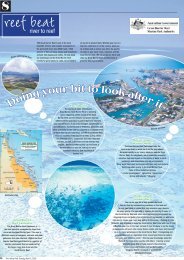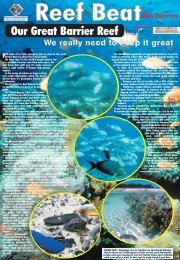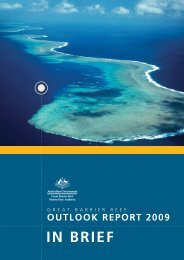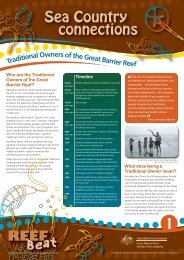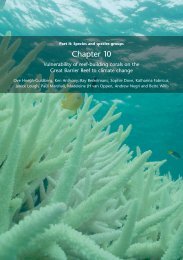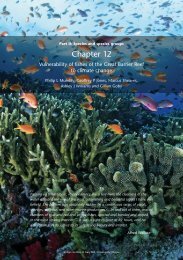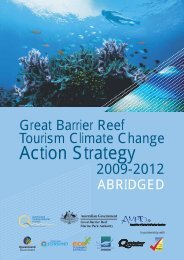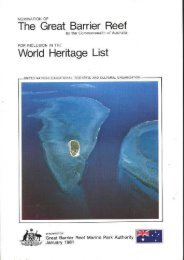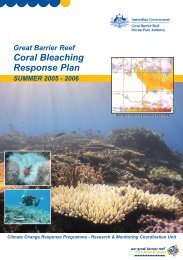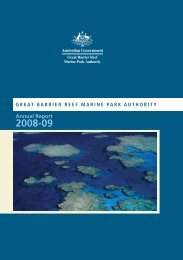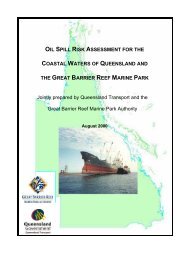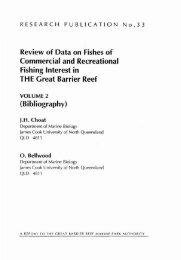ACTIVITIES BOOK - Great Barrier Reef Marine Park Authority
ACTIVITIES BOOK - Great Barrier Reef Marine Park Authority
ACTIVITIES BOOK - Great Barrier Reef Marine Park Authority
You also want an ePaper? Increase the reach of your titles
YUMPU automatically turns print PDFs into web optimized ePapers that Google loves.
Activity 2: The greenhouse effect in miniatureKey learning objective: Students will develop an understanding ofthe greenhouse effect by creating their own miniature greenhouse.Background: The greenhouse effect is called such because itreplicates the warming effect created in a real greenhouse. Whatbetter way to contemplate climate change than to build a minigreenhouse and watch its climate change? In this experiment, theclear container traps heat from the sun and moisture from the air.On a larger scale, this is similar to what happens in a full sizegreenhouse and on a much larger scale it explains why our planet isboth dry and icy cold. This activity can be done as a classexperiment or in small groups.What you will need:1. terrarium containers2. potting mix or soil from your school’s garden3. worm castings or mulch if available4. seeds (e.g. snow peas, flowers or vegetables)Instructions:Step 1: Collect some terrarium containers. These could be glass jars, plastic bottles, take awaycontainers, or juice cups. It’s important that they are clear,have lids that fit and are preferably recycled. Fill thebottom half of the container with soil. You might want toadd compost, mulch, or worm castings from yourworm farm.Step 2: Next add seeds or seedlings. Snow peasprouts are good because they grow quickly but smallferns or flowers are also good options. Water yourseeds or seedlings and watch them grow. You mightlike to add an insect or two. Make sure you put yourmini greenhouse somewhere sunny.Step 3: Record measurements like temperature,humidity and growth. Be sure to record thetemperature before you put the lid on so you cansee how temperature changes as the greenhouseeffect created by the container is enhanced overtime. Take readings in varying conditions (e.g.sunny vs. overcast, early morning vs. lateafternoon) and consider what factors cause yourgreenhouse to change. Try adding excess carbondioxide to your system and see what happens toplants.Step 4: Graph your results and report on what ishappening inside your mini-world. Consider thefollowing questions: How is what’s happening in yourgreenhouse like what is happening on Earth? When didthe temperature go up? Why? What happens if youtake the lid off?Why? Whathappens whenyou add morecarbon dioxide? Arethe impacts the samefor plants andanimals?Bright idea: Givestudents a range of‘data’ on weather andclimate conditions (e.g.newspaper clippings, dailyweather reports, yearly rainfallcharts for your state or territory,or thermometers and barometersthey can use to collect their ownmeasurements). Ask them toidentify which data relates toweather and which to climate. Havestudents explain the differencebetween climate and weather intheir own words and to describeboth the climate and weather oftheir town or city. Use localexamples and create a map orchart.Bright idea: Showstudents the GBRMPAanimation ‘What isclimate change?’(provided on <strong>Reef</strong> BeatDVD) and discuss the causes andsolutions of climate change.3<strong>Reef</strong> Beat 2009 - Climate Change and the <strong>Reef</strong>



